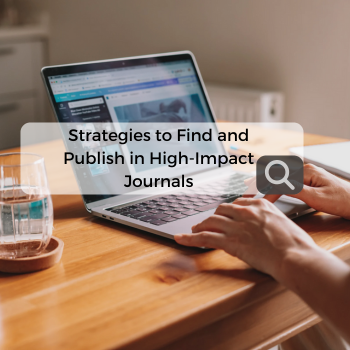1. Identify Relevant Journals in Your Field:
- Ensure the journal’s scope aligns with the research. Use keywords from the research to find journals with matching scopes.
- Check where researchers with similar studies are publishing. This can give insights into suitable journals.
2. Use Journal Finder Tools:
- Tools like Elsevier’s Journal Finder, Springer’s Journal Suggester, and Wiley’s Journal Finder can suggest journals based on your manuscript’s title and abstract.
- Refer to the Journal Citation Reports (JCR), Eigen factor, and article influence score to identify journals with high impact factors in the field.
3. Consider Journal Reputation and Metrics:
- While controversial, it’s still a primary metric. Aim for journals with higher impact factors.
- Use metrics like the h-index of journals to gauge their influence.
4. Consult Your Network:
- Experienced researchers can provide valuable insights into suitable high-impact journals.
- Discuss with peers at conferences to get recommendations.
5. Journal Acceptance Rates and Review Process:
- High-impact journals often have low acceptance rates. Understanding these rates can help manage expectations.
- Some journals have quicker review processes, which can be beneficial if you’re on a tight timeline.
Strategies to Increase Your Chances of Publishing in High-Impact Journals
1. Quality of Research:
- Ensure the research addresses significant questions and presents novel findings.
- Employ rigorous and reproducible methods. High-impact journals look for well-substantiated studies.
2. Manuscript Preparation:
- Make the manuscript clear, concise, and well-structured. High-quality writing improves readability and impact.
- Craft a compelling abstract and title as they are the first parts reviewers and editors read.
3. Enhance the Study:
- Use multiple methods to address the same research question. This can provide stronger evidence.
- Incorporate advanced or novel techniques that add value to the study.
4. Collaborations:
- Collaborate with experts in your field to enhance the study’s credibility and depth.
- Collaborate across disciplines to provide broader insights and appeal to a wider audience.
5. Data Presentation:
- Ensure the data is presented clearly with high-quality figures and tables. Visual appeal can enhance the paper’s impact.
- Provide comprehensive supplementary materials to support your findings without overloading the main manuscript.
6. Submit to Higher Impact Journals First:
Initially submit your manuscript to journals with higher impact factors. Even if it gets rejected, reviewer comments can be invaluable for improving the study before resubmission to another journal.
7. Revisions and Feedback:
- Utilize feedback from colleagues, mentors, and even professional editing services to refine the manuscript.
- When resubmitting, address all reviewer comments meticulously. Demonstrating a willingness to improve the study can enhance its acceptance chances.
The below-provided content from the article by Professor Sven Hendrix offers several strategic points, summarized below:
- Look for Mechanisms, Not Just Phenomena: Studies showing causal relationships tend to have higher impact.
- Use Multiple Methods: Employ diverse methods to validate findings, increasing the study’s robustness.
- Re-Analyze Samples: Extract more data from existing samples using different techniques.
- Add Innovative Techniques: Incorporate novel techniques to make the study stand out.
- Develop New Technologies: Creating and using new technologies can lead to higher citations.
- Collaborate with Statisticians: Proper statistical analysis is crucial, especially for complex datasets.
- Fuse Smaller Studies: Combining complementary smaller studies can create a more substantial publication.
- Collaborate with Experts: This can enhance the study’s quality and provide access to better resources.
- Select Appropriate Journals: Choose journals whose scope matches your study and where the competitors publish.
- Submit for Reviewer Feedback: Even if aiming high initially, feedback from top journals can help improve the manuscript.
To publish in high-impact journals, focus on the quality and novelty of the research, use diverse and robust methods, collaborate with experts, and choose the right journals carefully.
Source links:


